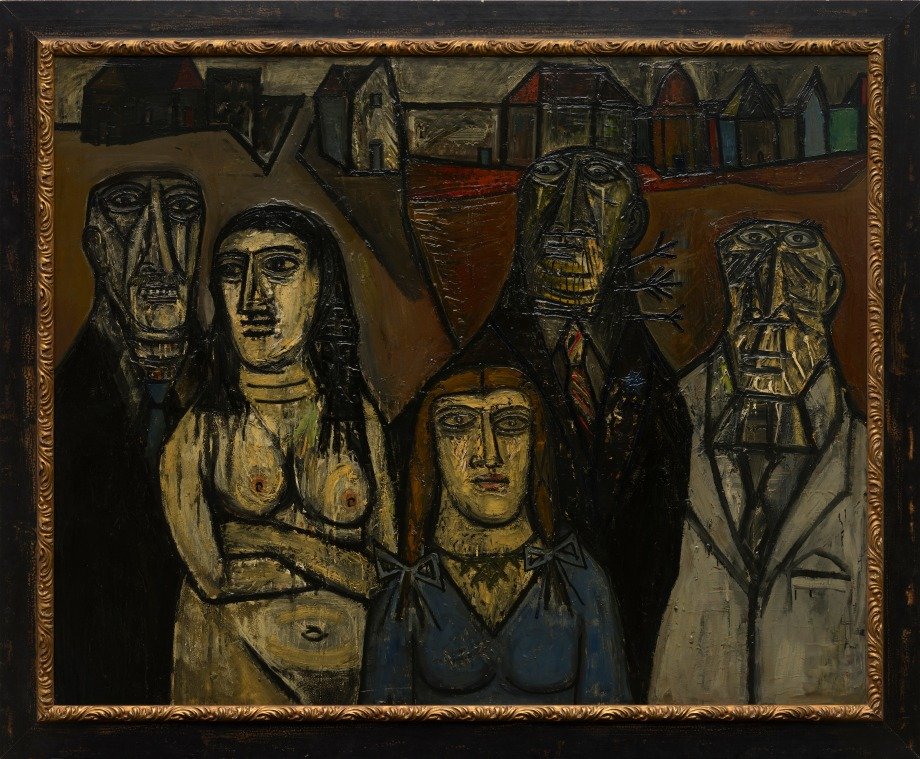Francis Newton Souza “Straddles Several Traditions but Serves None”
Francis Newton Souza (1924–2002) was an Indian modernist painter renowned for his art writing and founding membership of the Bombay Progressive Artist Group in 1947. Aicon Gallery’s current show, Francis Newton Souza: A Celebration of the Centenary, honors his seven-decade-long career. The artist’s compositions are weighed down by slicks of oil paint and grotesque yet expressive brushstrokes. But to restrict Souza’s painterly style into a neatly contained definition would be remiss: he was a bold painter who staunchly defended the artist’s right to paint freely and honestly. Throughout his life, Souza rejected the push from many groups to stylistically assimilate to their respective movements. Souza’s prolific painting career was supplemented by a rich ability to articulate his artistic practice through writing. A prolific collection of his essays and drawings can be found in his book Words and Lines, originally published in 1959. Aicon Gallery’s harmonious selection of Souza’s work serves as a salient reminder to the contemporary painter of the virtues of honest collaboration with the paint.
While certain stylistic congruities can be traced throughout Souza’s oeuvre, his technique is not formulaic. Souza traverses style and imagery, which allows each of his paintings to stand on their own. Untitled (Man in Tunic) (1961) is a unique member of the show at Aicon Gallery; with its bright colors and exposed canvas, it stands out from the many dark and heavy paintings that surround it. The curatorial arrangement is not chronological; instead, it unifies Souza’s multifaceted career by considering each painting’s composition as but one part of a myriad whole.
Untitled (Black Nude) (1965) hangs on the opposite wall of the gallery and is a composition that possesses almost the complete opposite qualities of Untitled (Man in Tunic). Untitled (Black Nude) is part of a series of works in which the artist coated a previously finished painting with slicks of obsidian paint. The resulting effect allows for only a minimal amount of detail, emphasizing Souza’s signature grotesque marks which crudely outline a nude feminine sitter. Man in Tunic and Black Nude were made only a few years apart from each other and are demonstrative of Souza’s diverse artistic practice.
When first familiarizing oneself with Souza’s work, the word “experimental” might come to mind. The artist rejects this in his essay “A Fragment of Autobiography,” found in Words and Lines, and instead asserts that “a work of art cannot be an experiment and must be unique.” Recounting his experience as a member of the Communist Party of India and feeling pressured to create propaganda art, Souza again demands his independence, stating, “An artist does not paint for the proletariat. I believe with all my soul that he paints for himself.” Souza writes about his relationship to painting in lyrical prose that gives us a clear account of his embodied and individualist approach to painting, which has given Souza’s career its organic and distinct place among his modernist contemporaries.
As Aicon Gallery commemorates the centennial of Francis Newton Souza’s life, the contemporary art world benefits from his unapologetic legacy. The frenetic intimacy that has been preserved in paint serves as a testament to Souza’s commitment to painting for oneself. Artists will always feel pressure from outside sources—be it history, the art market, or traditional modes of education—to assimilate stylistically. It is difficult to rid oneself of these constraints, but Souza’s retrospective at Aicon Gallery reminds us of the merits of painting for yourself.
Francis Newton Souza: A Celebration of the Centenary is on view at Aicon Gallery through December 14, 2024.





